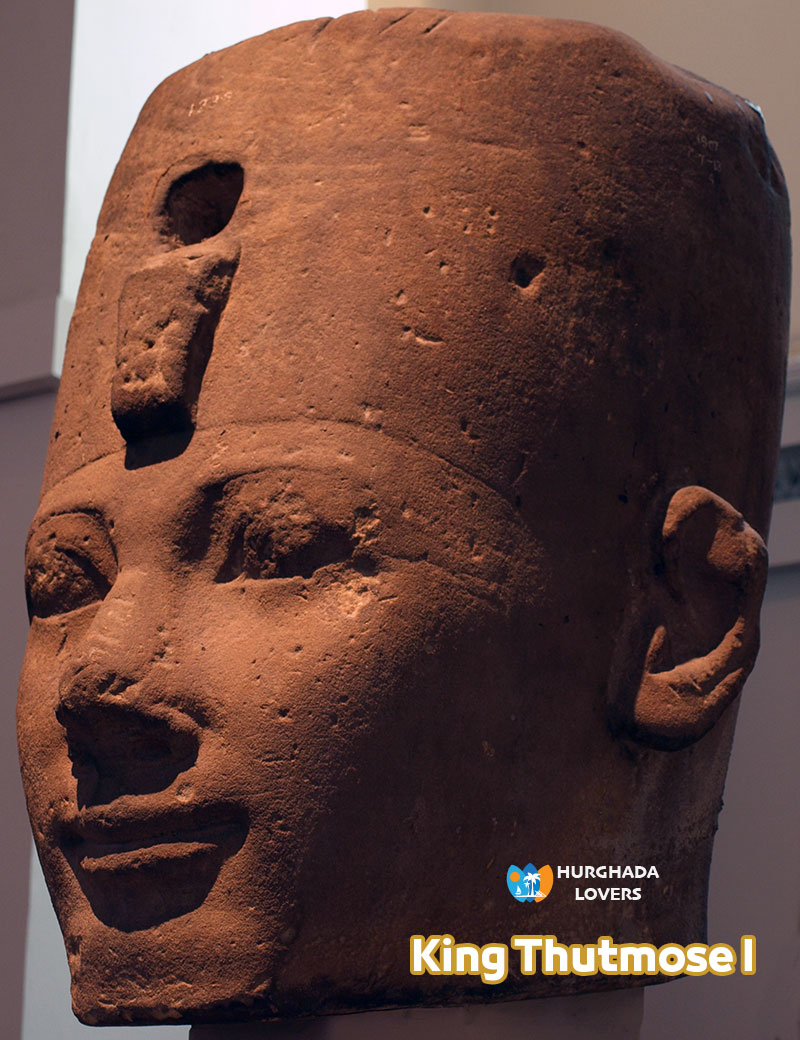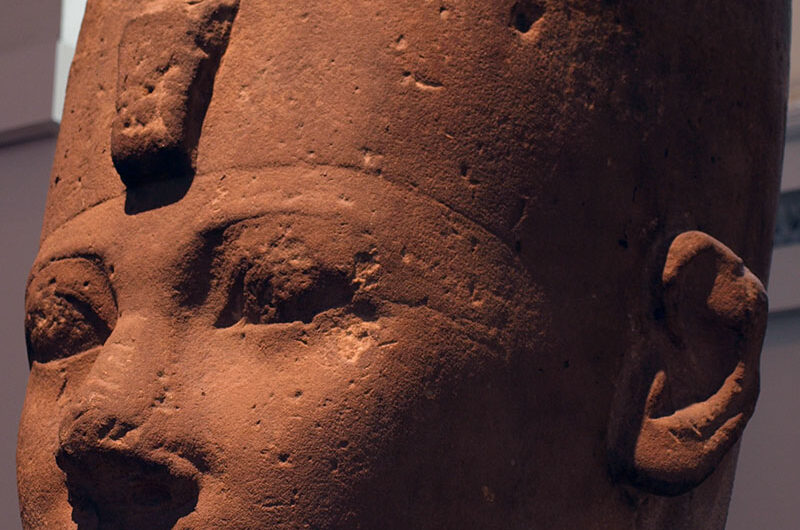King Thutmose I – Egyptian Pharaohs kings – Eighteenth Dynasty of Egypt – The New Kingdom
Facts and history of the greatest Egyptian warrior kings of the Pharaohs in the Eighteenth Dynasty, secrets, Biography, achievements in the Ancient Egypt, tomb, Mummy, life and death of the king and his Pharaonic antiquities, the dynasty of the New Kingdom of Egypt, and more about Ancient Egypt History.
King Thutmose I
Ruling period in Ancient Egyptian Government: 1526–1513 BC
Date of death: 1493 BC
Father: king Amenhotep I
Mother: Queen Sensab
Wife: Queen Ahmose, the most famous Pharaonic queen of Egypt, Queen Mut-Neferet “Female Pharaohs”
Children: King Thutmose II, Queen Hatshepsut.
Archaeology:
- Stone statues to indicate the development of the craft of Sculpture in Ancient Egypt,
- Tomb of King Thutmose I + Queen Hatshepsut | KV20 in Valley of the Kings Tombs in Luxor, Thebes, southern Egypt.
- The Hypostyle Hall and two Obelisks, “the Obelisks of the Pharaohs,” in the Karnak Temple complex, the most famous Egyptian Temples.
- King Thutmose I was one of the pharaohs of the Eighteenth Dynasty. He ruled Egypt from 1506 to 1493 BC. It is said that he ruled Egypt when he was a little over forty years old. He assumed power after the death of Amenhotep I. Learn more information about King Thutmose I below..
King Thutmose I Facts
- The Pharaonic king assumed the rule of the throne of ancient Egypt after the death of his father, King Amenhotep I, the most famous king of the Pharaohs.
- The Pharaonic king is considered the third king of the Eighteenth Pharaonic Egyptian Dynasty in the era of the New Kingdom in ancient Egypt.
- He was interested in fighting the neighbors, carrying out military campaigns, and strengthening the Military of ancient Egypt, especially southern Egypt, according to the people of Nubia, as in Geography of ancient Egypt.
- King Thutmose I loved hunting elephants and animals in the forests, “Ancient Egyptian Sport” after completing his military campaigns and leading the army in ancient Egypt. Inscriptions were discovered in Tomb of Ahmose son of Ebana, within Tombs of El Kab Or Elethya in Aswan, one of the king’s close servants, stating that King Thutmose I I enjoy hunting in the forests of Asia.
- King Thutmose I gave birth to Queen Hatshepsut, the most famous Pharaonic queen of Egypt throughout history. She has the Mortuary Temple of Hatshepsut in Deir El Bahari and Tomb of Queen Hatshepsut | KV60 and King Thutmose II..
- The king was buried in the tomb of King Thutmose I, the Valley of the Kings tombs in Luxor.
- King Tuthmosis I died in 1493 BC and was buried in tomb number 38, after which he was transferred to tomb number 20..
- The king left a group of Egyptian Monuments, including the fourth and fifth gates, in addition to two obelisks and the Hypostyle Hall in the Karnak Temple.
- The son is Amenhotep I, while the mother is “Sebseneb”. He married and gave birth to Thutmose II and Hatshepsut..
- King Thutmose built a group of funerary Mortuary Temples, in addition to his tomb located in the Valley of the Kings.
The origin of King Tuthmosis I
- King Thutmose I’s parents belong to a non-royal family, and it is said that Thutmose’s mother may have been Ahmose’s secret wife..
- Among the speculations of Egyptology is that Thutmose’s mother was the daughter of Ahmose I and the sister of Amenhotep I, but there is no evidence that she was called the king’s daughter..
- Some historians and Egyptologists also believe that she was Thutmose’s sister, but that story has been denied.
- Thutmose had a son, “Wajmes,” in addition to Hatshepsut and Queen “Neferupti.”“.
- The son died before his father, while Neferuti died when she was an infant.
- King Thutmose I had another son from his wife, Mutneferu, and the son was Thutmose II.
Period of rule
- Historians say that the year of the coronation of King Thutmose I and the Coronation of the Pharaohs was 1506 BC, and it is likely that it was the city of Memphis.
- But other historians date the year of the king’s coronation as 1526 BC.
- The last opinion: A group of evidence dating back to the eighth or ninth year of the reign of King Tuthmosis I confirms this.
- An inscription was found engraved on a stone block located in Karnak to indicate the development of Architecture in ancient Egypt. According to it, historians concluded that the period of the king’s rule was from 1506 to 1493 BC..
- Until now, there are others who believe that the king’s reign period began from the year 1526 until 1513 BC..
Achievements
- The rule of King Thutmose I, a contemporary of rebellions and Revolutions in Ancient Egypt in the Nubia region against Egyptian rule.
- The tomb of Ahmose ibn Ebana explains the king’s behavior in response to this rebellion, by traveling up the Nile River to fight a battle in which he succeeded and killed the Nubian king..
- The king hung the body of the Nubian king on his chariot during his return to Thebes.
- Another campaign carried out by Thutmose against Nubia was in the third year of his rule, during which he bulldozed the canal located at the first cataract..
- He did this in order to facilitate the process of water flow and the development of Agriculture in Ancient Egypt, and thus this matter helped in the integration of Nubia with the Egyptian Empire.
- While in the second year of his rule, the king cut a memorial plaque in the Tombs area, an area located in Nubia.
- King Tuthmosis I built a castle in the same area and thus succeeded in introducing the Egyptian army into the Nubia region.
- The king was not satisfied with this number of campaigns, but he also launched a campaign against Syria, and the Syrian princes declared loyalty to the king.
- The king stopped the tax imposed on them, and began building fortifications.
- A rebellion from Nubia occurred again at the end of the fourth year of his reign, and during that period his influence reached the far south.
Monuments of King Thutmose I
- King Tuthmosis I achieved a large number of victories, and in order to be able to celebrate the Pharaonic holidays “Festivals in Ancient Egypt” with them, he built a large hall in the temple of God Amun, the most famous ancient Egyptian deities, in Karnak..
- He also reconstructed the temple in Thebes and built two obelisks in front of the fourth gate in the Temple of Amun.
- To date, only one of the two obelisks exists, which is made of granite “Ancient Egyptian Metallurgy“, approximately 60 meters long and 22 meters wide.
- There are also traces of the king that were discovered in the Giza area, Elephantine Island “Aswan“, Armant, and Sinai, as well as in the Memphis area..
Tomb of King Tuthmosis I
- King Tuthmosis I died in his fiftieth year and was buried in the tombs of the Valley of the Kings.
- His manager, Enni, prepared this tomb for him, and it is covered with plaster and comes with a group of colorful engravings.
- There are inscriptions on the tomb bearing the title Secret Chamber Messages, and the inscriptions are written in the Ancient Egyptian Language cursive hieroglyphic language..
- So far, only a few fragments remain from the tomb, and his mummy was transferred to the tomb of his daughter, Queen Hatshepsut, which was also prepared for him..
- The mummy of King Thutmose I is currently located in The Egyptian Museum “Museums in Cairo” in Tahrir Square, and after conducting a group of tests, which showed that the king was suffering from a number of issues..
- One of the diseases that the king suffered from was rheumatoid arthritis, and a fracture was found in his pelvis.
Note: Facts and secrets of the history of the Pharaoh kings will be added soon…
Hurghada Excursions Lovers, Best Travel Agency in Hurghada to provide daily tours to visit the Tourist attractions of Luxor by Hurghada to Luxor Tours.

